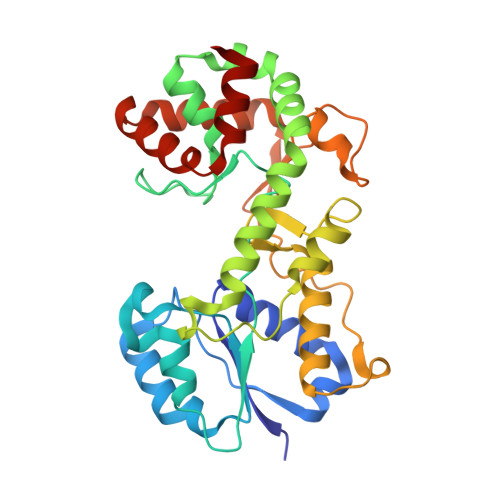Structural Insights Into Wcbi, a Novel Polysaccharide-Biosynthesis Enzyme.
Vivoli, M., Ayres, E., Beaumont, E., Isupov, M.N., Harmer, N.J.(2014) IUCrJ 1: 28
- PubMed: 25075317
- DOI: https://doi.org/10.1107/S205225251302695X
- Primary Citation of Related Structures:
4BQN, 4BQO - PubMed Abstract:
Capsular polysaccharides (CPSs) are protective structures on the surfaces of many Gram-negative bacteria. The principal CPS of the human pathogen and Tier 1 select agent Burkholderia pseudomallei consists of a linear repeat of --3)--2-O-acetyl-6-deoxy-β-d-manno-heptopyranose-(1-. This CPS is critical to the virulence of this emerging pathogen and represents a key target for the development of novel therapeutics. wcbI is one of several genes in the CPS biosynthetic cluster whose deletion leads to significant attenuation of the pathogen; unlike most others, it has no homologues of known function and no detectable sequence similarity to any protein with an extant structure. Here, the crystal structure of WcbI bound to its proposed product, coenzyme A, is reported at 1.38 Å resolution, solved using the halide-soak method with multiple anomalous dispersion. This structure reveals that WcbI incorporates a previously described 100-amino-acid subdomain into a novel, principally helical fold (310 amino acids). This fold adopts a cradle-like structure, with a deep binding pocket for CoA in the loop-rich cradle. Structural analysis and biophysical assays suggest that WcbI functions as an acetyltransferase enzyme, whilst biochemical tests suggest that another functional module might be required to assist its activity in forming the mature B. pseudomallei capsule.
Organizational Affiliation:
College of Life and Environmental Sciences, University of Exeter , Geoffrey Pope Building, Stocker Road, Exeter EX4 4QD, England.


















